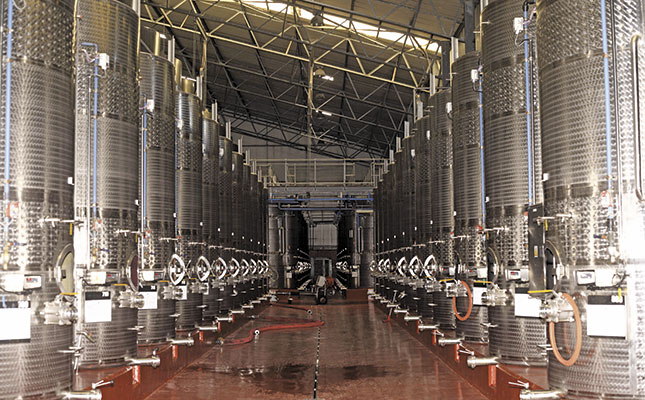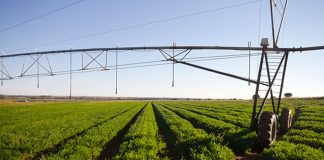
Photo: Glenneis Kriel
Environmentally responsible production has always been important at Durbanville Hills wine cellar in the Western Cape. The philosophy is carried through from the vineyards of the growers who supply the cellar with grapes, to the way in which waste water is treated at the cellar itself. In 2004, Durbanville Hills received ISO 14001 accreditation; an environmental management standard that aims to help organisations adopt environmentally friendly operations.
READ:Efficient feeding during drought
To maintain this accreditation, the cellar has to continuously find new ways to further reduce their ecological footprint. So, in 2012, an energy audit was conducted to identify ways to reduce its energy footprint, with the idea of incorporating solar or wind energy into the production system. “We thought our position on this koppie between Durbanville and Cape Town was ideal for the generation of wind energy,” says Martin Moore, cellar master at Durbanville Hills. “Feasibility studies however found the wind too gusty for the generation of wind energy.”
In addition to wind energy being unfeasible for the area, both forms of renewable energy were found to be too expensive to justify the investment. It would have taken more than 30 years – the average lifespan of a wind energy system – for the wind infrastructure to pay for itself. The same was true for a solar system. The system would have paid for itself in a little under 20 years, which is the average lifespan of a solar system.The solar system would have been more affordable if the cellar was able to buy it without a loan, but the wind energy system remained a no-go even if it was self-financed.
Nevertheless, Moore is optimistic that the cellar will incorporate solar energy in some form within the next few years. “Although solar energy is still too expensive for us now, it will become more affordable as more people start to use it and the technology improves.” The energy audit revealed various other ways in which the cellar could save energy. “It paid to get someone from outside to evaluate the system. Most of the interventions were straightforward behavioural changes, but those of us who have been working at the cellar for years have become so blinded by the status quo that it didn’t occur to us.”
Compressors
Refrigeration and cooling proved to be the biggest consumers of energy, with the air compressors ranking second after the three compressors cooling the water reservoir. Durbanville Hills has a good maintenance programme, so inefficient compressors due to air leakages weren’t a problem. Room to save energy existed in lowering the pressure at which the air compressors worked. Moore explained that compressors use most of their energy while switching on and off. By lowering the pressure from 8,4 bar to 7,7 bar, the cellar managed to lengthen their operating times and significantly reduce restarts. Moore is unable to quantify the savings, but says it was significant.
Cooling reservoir
The reservoir contains water that is pumped through the cellar to chill wines during the fermentation process. It holds 150 000l, and is much bigger than needed. This proved to be a blessing in disguise, because water in a big reservoir will take longer to heat up than water in a smaller reservoir.
Water in the reservoir will heat up over time if the water is not kept cool, due to ambient temperatures and because water circulating through the system will be several degrees warmer once it returns to the reservoir, Moore says. To save energy, the cellar moved from continuous temperature control – where temperatures were maintained at about 6°C throughout the day – to a more lenient system where the water was cooled during off-peak hours (when electricity prices are lower) to about 4°C.
The water is then left for the rest of the day, to rise to temperatures of up to 6°C, before being cooled again. At the time of instituting this change, the difference between off-peak and peak tariffs was 90c and R1,60 respectively, says Moore.
Cooling tanks
Previously the cellar’s cooling tanks were regulated manually. Now, tanks are cooled automatically once temperatures reach a set degree. White wines are fermented at temperatures between 12°C and 16°C, depending on style and stage of fermentation. Cooling is reduced towards the end of fermentation to ensure the yeast completes the fermentation process.
The timing of the automatic pump-overs on the red wine fermenters has also been set, to ensure that they pump over in a sequence instead of creating a peak usage by starting up at the same time. “In the past we would have to open the cooling valves for a few tanks at the same time. This placed pressure on the pumps and also resulted in large volumes of warm water returning to the reservoir at the same time.
The automated system is much more subtle and accurate than one managed manually.” Moore explains that the system results in smaller volumes of water running through the system, which in turn results in smaller volumes of warm water returning to the reservoir and helps to reduce pumping costs.

Martin Moore, cellar master at Durbanville Hills wine cellar, stands under a strip of old skylights. These skylights did not provide enough natural light, and the cellar has since installed 24 light sculptures that harvest natural light.
Mash cooler
The mash cooler is used to cool down white grapes after they have been destemmed. The cellar synced it with the grape crusher, which means that it only works when the crusher works. Moore relates that previously they started up the mash cooler once the first delivery of grapes arrived, and kept it running until they finished with the last delivery of the day. He estimates that they are saving about R57 000/year.
Running the mash cooler alongside the crusher has also resulted in less warm water returning to the cooling reservoir, as water from the reservoir is also used in the mash cooler. The incorporation of variable speed drive (VSD) pumps, says Moore, has saved them up to 45% in pumping costs. Previously pumps were run at full capacity. Now, the cellar has installed starters that allow the pumps to work more efficiently. The pumps, of which there are several sizes, are never switched off, but remain idle until needed.
Lighting
- Energy-saving bulbs: The cellar systematically switched to energy-saving bulbs. Choice of bulb depends on energy usage, energy efficiency, shelf life and price. In general, these bulbs use about a quarter of the amount of electricity used by traditional light bulbs, and also last more than twice as long – between 6 000 and 15 000 hours, according to Moore.
- Light sculptures: The cellar was originally built with skylights, but these did not provide enough natural light to switch off the lights during the day. The cellar installed sun-harvesting light sculptures, which work with a prism and lenses to concentrate sunlight into the building.“Since installing the light sculptures, the cellar hardly ever has to make use of their ordinary lights during the day, unless it is overcast or raining,” Moore says. The cellar installed 24 of the sculptures at a cost of R2 600 each. The total cost, including installation, amounted to about R250 000. “It was worth it. The use of these light sculptures on their own has helped to reduce electricity costs during peak season by about R9 000 per month. The cost for about two of these lights is recuperated in savings winthin a month of installation.”
- Automated lighting: Moore explains that a sensor ‘reads’ how much light there is in the cellar, and, once the natural light levels fall below a certain point, the electric lights are switched on automatically. The lights will switch off when enough natural light becomes available.
Monitoring energy use
The cellar has installed various monitoring measures to gauge its energy usage. “Monitoring our energy usage helps us to keep a tab on things, so we can quickly identify irregularities and rectify matters as they occur.” Although the cellar does use a backup generator in case of load-shedding, Moore says they try to schedule operations around load-shedding as running the generator is very expensive.
It is difficult to quantify total savings in monetary terms, due to the difference in peak and off-peak electrcicity prices, and because the cellar took in more grapes in 2014 than in 2013. However, Moore estimates that the cellar has saved about 122 000kWh time, rendering the investments in the energy audit and new technology more than worthwhile.
Phone Martin Moore on 021 558 1300 or email him at [email protected]
This article was originally published in the 11 September 2015 issue of Farmer’s Weekly.












